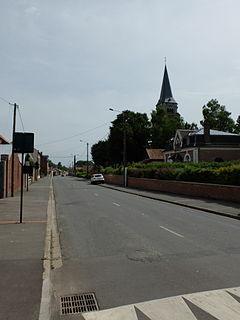Jehan de Nuevile (c.1200–c.1250) was the second son of the Eustache de Nuevile, a minor nobleman with land in Neuville-Vitasse, near Arras. Jehan succeeded to the patrimony on the death of his elder brother, Eustache. He himself was dead by 1254, when his younger brother, Gilles, appears as lord at Neuville. Jehan is better known as a trouvère.

Neuville-Vitasse is a commune in the Pas-de-Calais department in the Hauts-de-France region of France.

Arras is the capital (chef-lieu/préfecture) of the Pas-de-Calais department, which forms part of the region of Hauts-de-France; prior to the reorganization of 2014 it was located in Nord-Pas-de-Calais. The historic centre of the Artois region, with a Baroque town square, Arras is located in Northern France at the confluence of the Scarpe river and the Crinchon River.
Trouvère, sometimes spelled trouveur[tʁuvœʁ], is the Northern French form of the langue d'oc (Occitan) word trobador. It refers to poet-composers who were roughly contemporary with and influenced by the troubadours but who composed their works in the northern dialects of France. The first known trouvère was Chrétien de Troyes and the trouvères continued to flourish until about 1300. Some 2130 trouvère poems have survived; of these, at least two-thirds have melodies.
Colart le Boutellier dedicated one of his songs to Jehan. The song L'autrier par un matinet, dedicated to Colart, may be a response from Jehan, although there are competing attributions. The Chansonnier du Roi (BnF fr.844) ascribes sixteen chansons courtoises to Jehan in its table of contents, although six of these are attributed to two other poets, Gautier d'Espinal and Guiot de Dijon, in the rubrics. Only three of Jehan's pieces survive with melodies in the Chansonnier to Roi and these are his only pieces to appear in other manuscripts:
Colart le Boutellier was a well-connected trouvère from Arras. There are no references to him independent of his own and others' songs, found in the chansonniers. One of these depicts the known coat-of-arms used by the Boutillier family, one of the petty noble clans of Arras, and assigns it to Colart. Another manuscript does not show any arms for Colart and it can be surmised that he was in fact a member of one of the middle-class families of the same name that could then be found in Arras. He may have been a relative of Robert le Boutellier, who judged a jeu parti between Thomas Herier and Gillebert de Berneville.

The Manuscrit du Roi or Chansonnier du Roi is a prominent songbook drawn towards the middle of the thirteenth century, probably between 1255 and 1260 and a major testimony of European medieval music. It is currently French manuscript 844 of the Bibliothèque nationale de France. It is known by various sigla, depending on which of its contents are the focus of study: it is troubadour manuscript W, trouvère manuscript M, and motet manuscript R.

Gautier d'Espinal was a French composer and trouvère poet of the 13th century.
- Desoremais est raison
- Quant li boscages retentist
- L'autrier par un matinet
Jehan's chansons are generally heptasyllabic and isometric. All are in bar form. Also surviving on Jehan's name is a complainte, an Old French variant of the Old Occitan planh , a form rare in northern France. Its music is lost.
Bar form is a musical form of the pattern AAB.
Old French was the language spoken in Northern France from the 8th century to the 14th century. In the 14th century, these dialects came to be collectively known as the langue d'oïl, contrasting with the langue d'oc or Occitan language in the south of France. The mid-14th century is taken as the transitional period to Middle French, the language of the French Renaissance, specifically based on the dialect of the Île-de-France region.
Old Occitan, also called Old Provençal, was the earliest form of the Occitano-Romance languages, as attested in writings dating from the eighth through the fourteenth centuries. Old Occitan generally includes Early and Old Occitan. Middle Occitan is sometimes included in Old Occitan, sometimes in Modern Occitan. As the term occitanus appeared around the year 1300, Old Occitan is referred to as "Romance" or "Provençal" in medieval texts.